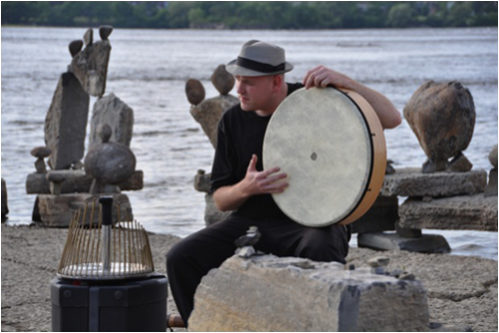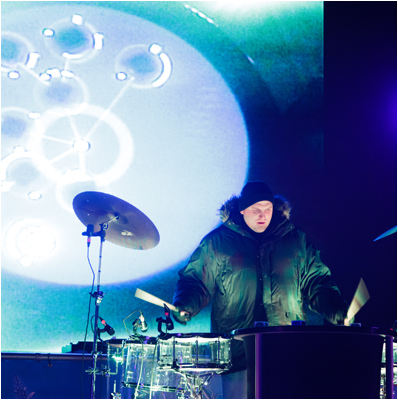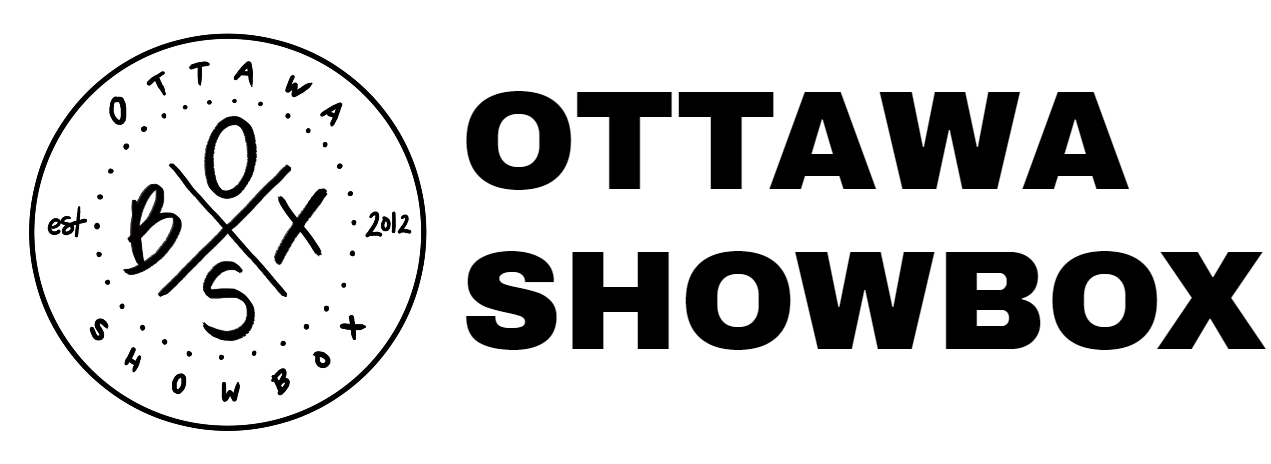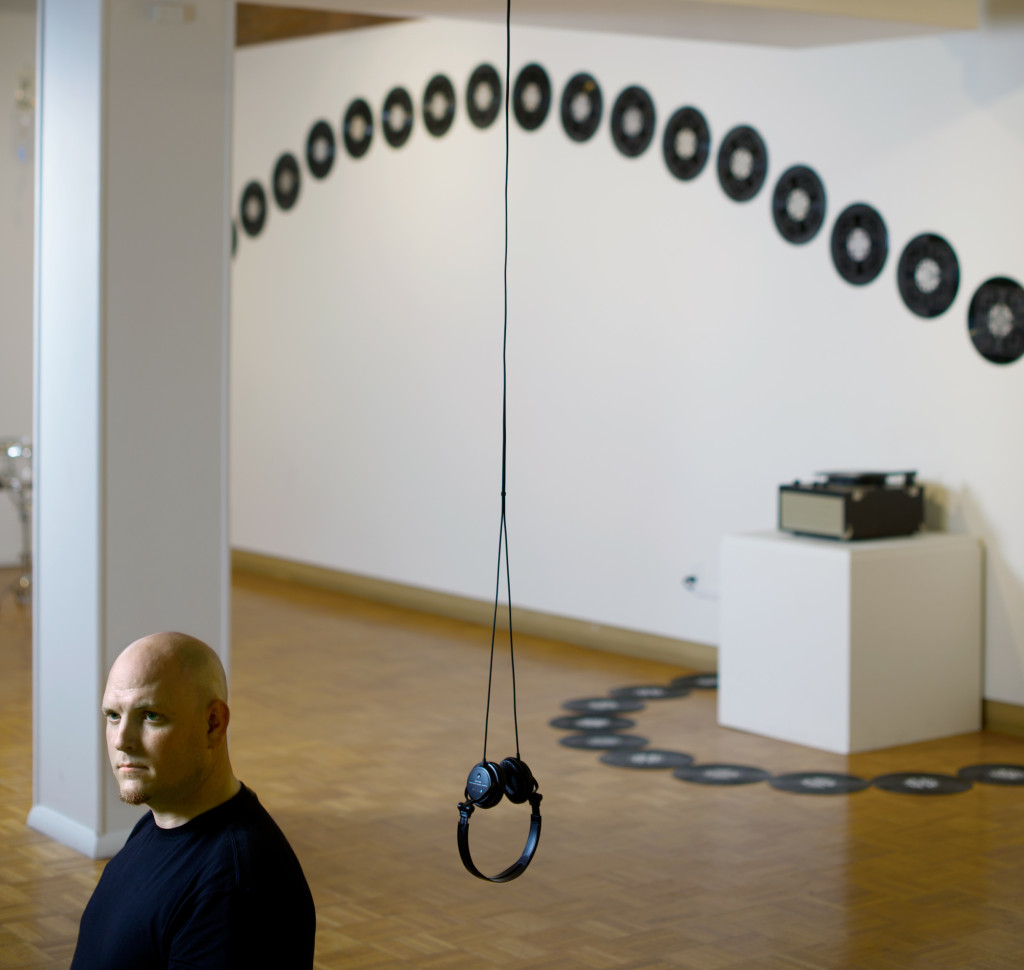Interview: Jesse Stewart, Percussionist, Instrument Creator & Educator

Photo by Michele McMillan
This is about a man enraptured by sound, someone who never stopped hitting on pots and pans once he grew up. Oshawa-born Jesse Stewart will be the focus of Ottawa Chamberfest’s Siskind Snapshot on Friday, Aug. 1 at 5:45 p.m. at the Dominion-Chalmers United Church showcasing his stellar performance later that evening at St. Brigid’s Centre for the Arts. “Sounds From Space” will be unlike anything you have ever seen or heard… Tickets are $30 and might run out soon. The full title of the show is “Sounds From Space: The Voyager Golden Record Remix Project.”
For six years, Jesse has taught a number of classes at Carleton University, including music composition, improvisation, and jazz history among others. Before Ottawa, he lived in Guelph where he formed the band Stretch Orchestra (formely Tallboys) with Matt Brubeck & Kevin Breit. Their debut self-titled album won them a JUNO Award in 2012 for Best Instrumental Album of the Year. We had the chance to chat with him last week.
Q & A with Jesse Stewart
You’ve done so much varied work in visual, audio & multimedia art that you have a long list of titles growing after your name. What describes you best: creator, percussionist, or educator?
I guess the two that stand out for me are creator and educator. A creator is an artist, and that doesn’t necessarily mean one idiom. Because I work in visual and sonic arts I do a range of different things in those areas. But I teach as well, for me those are both connected. My career as an educator is closely linked to the creation of art. I don’t think I’ve ever had a student that I haven’t learned from.
You’ve been teaching at Carleton University for six years now, but how has this year been different?
This past year I was not teaching because I received the Marston LaFrance Research Fellowship. There’s one per year. It buys a faculty member out of teaching for that year. I am fortunate enough to be able to focus on my own work — lots of recording, playing, writing — this year, and as you may know university faculty get a sabbatical every seventh year. So this is now my sabbatical where I’m not teaching, I’m free to focus on my own work again.
I look forward to going back because I love teaching but it’s been very nice to have an extended period of time to focus on my own research. I’m still doing a range of different things that have pedagogical aspects to them. In Newfoundland I taught for a couple weeks at a summer institute for graduate students. This fall I’m teaching at the Discovery University created by the Ottawa Mission. I’ve only taught a couple classes there but I’d be happy to have the chance to do more with them. More and more I’m doing community music initiatives, basically collaborations with a community organization. I was the artist-in-residence at the Regina Street Public School, and the whole school, about 160 kids, and I put on a show. That’s a very clear example of initiatives where my background as an artist and as an educator coincide.
You’ve worked with an organization called H’Art of Ottawa, which actively encourages creativity & self-expression for those with developmental disabilities. Could you tell us a little about the “multimedia opera” Turning the Page you put on with them in April of this year?
The organization facilitates art-making for all types of people with disabilities, and one time the executive director of H’art [Lin Rowsell] and I were speaking at the same event. She showed the images of artists’ paintings, and I thought they were amazing so I went up to her later to tell her I was taken with the images. She asked, would you ever want to collaborate with us? And I said I’d love to. So every week for the past six to eight months I’d be with a different group and bring in some percussion or electronic instruments and we’d make music together. The idea was to just sort of let this project emerge on its own. I wasn’t telling anyone what to play, I’d just bring stuff in and just see what would happen. Together we decided what parts we’d like to incorporate into this musical theatre. Images of the artists were projected during the whole performance, and we used a variety of found objects as instruments, percussion instruments, iPads with an Adaptive Use Musical Instruments (AUMI) software that transforms movement into sound, and the reactable.

Can you describe the reactable instrument for us?
The reactable is digital sampler and synthesizer that takes the form of an illuminated table. Basically, the table is a kind of interface for controlling sound and sound synthesis on a laptop. By placing objects on the surface of the table I can trigger different sounds, add filters, oscillators, sub-oscillators, and wave forms. It allows me to create electronic music live so it’s not just pressing play and checking my email. I’m actually controlling every sound with a visual interface. It’s very intuitive — groups of people who don’t necessarily have musical training figure it out quite quickly. It has allowed me to realize an idea I’ve had in mind, probably over the last 10 years, to create an extended composition using the recordings that were sent into space in 1977 on the Voyager spacecraft. I’ve always wanted to use those pieces as source material to create something new.
On Friday Aug. 1 you’ll be showcasing that project you call “Sounds from Space,” a remix of the music and images on the two golden records sent into deep space on the Voyager shuttles. Please tell us more!
I started tracking down copies of the recordings much before you could just go online and find them. The idea was “what if an alien species finds these spacecraft?” That’s a big reason they were being sent to drift throughout space for all eternity. Carl Sagan said if you’re going to do that it’s an opportunity to have a message in a bottle, and the message took shape in these gold-plated copper records. Lots of different music, sounds of Earth, and greetings in 80-odd languages were encoded along with over 100 images. About 10 years ago I started to think if it was found and successfully decoded, what would they do with it? What if this alien race didn’t necessarily have any art or music or culture of its own? What if they took this music and images and used them to construct an art of their own? What would that look like? What would it sound like?
I really have to give props to Roman Borys, the artistic director of the Chamberfest, for this. We’ve been talking about much bigger projects for years now and he contacted me several months ago to tell me this was the year to realize one of those projects at the festival. I sent him 10 or 12 ideas of larger-scale projects and he suggested we do “Sounds from Space.” When I first conceived this project I thought I’d be using turntables but now I have the reactable. Technology has caught up to the idea so I felt like the time had come too. Roman is programming what people would expect out of a chamber music event but he’s also taking chances on a lot of things. He’s pushing boundaries of how we conceive chamber music and I’m honoured to be a part of it.
Essentially, I’m creating the performance specifically for Chamberfest, and I’m very happy to be able to perform it first in Ottawa. In addition to this musical remix there is also a visual component. I’ve been working with local filmmaker Colin Power to have a little video of the still images from the golden records animated. I do want the performance to be documented and I hope to tour this piece. I’m already booked to perform it in May 2015, so maybe I’ll have a chance to perform it again before then.
Jesse presenting at TEDxCarletonU in 2010
You create instruments and use unusual musical devices throughout your art. Where does this fascination for peculiar sounds come from?
I think a lot of it is fueled by curiosity, really. One of the things I love about music in general is the sense of wonder that can go along with a musical experience. A lot of what I do is based on that, what I think of as a quest of discovery. It extends in the way I approach the drum set, probably the instrument I’m most associated with. I’ve played drums in the conventional way but also in a range of unconventional or “extended” techniques, as a way of discovering new and unexpected sounds even from familiar instruments.
That process of experimentation goes into other things, and the way I interact with the world around me. I’m constantly tapping on everything, looking for sounds I’ve never heard before. How can I interact with this familiar object so it produces an unexpected sound? I’ve done a whole concert on a piece of cardboard before. I use rocks, sea shells, saw blades, bits of garbage I can find, and sometimes I even look for things backstage before the show.
I’ve built instruments out of ice, stone, cardboard, newspaper, and other various types of paper. Again it’s all motivated by this sense of curiosity and exploration.
Do you have a catalog of the instruments you possess?
I don’t have a catalog but my website has some pictures of the various things that I play. Of course I play instruments that I haven’t built too. I went through a phase around 1996 or 1997 where I made all kinds of instruments out of glass. I made a glass marimba, an udu drum, a flute, and almost all of them have broken by now. It’s one of the dangers of making things out of glass.
What is your favourite instrument?
My favourite instrument is the one I have yet to discover. The drum is my first instrument, I’ve always banged around on pots and pans. When I really started to study drums I loved playing them in part because it combines many other instruments of different cultural traditions. In order to accommodate the growing rhythmic complexity of the music, early jazz and ragtime drummers had to have a variety of different toms, they combined the snare drum and the bass drum, cymbals from Turkey, and originally the tom-tom was a Chinese drum. I like that, the fact that it’s got these bits and pieces from all these different traditions.
And I really do like the fact that there are many universes of sound within the drum set. You can play them with sticks but I’ve dedicated myself for the last 15 years to try and explore other nuances to create a kind of expanded vocabulary for the instrument. What I’ve found is that this vocabulary is infinite.
What are your writing projects these days?
I’m currently writing a book about jazz history where each chapter is a look into the relation between jazz and another genre: so afro-cuban music and jazz, hip hop and jazz, western music and jazz, etc. That’s one book on the go, and the other I’m co-authoring with Ajay Heble on the pedagogy of musical improvisation.
Are you still making music with Matt Brubeck & Kevin Breit as Stretch Orchestra?
Yes we are, we have a show in September at the Guelph Jazz Festival. We have a few other things in the fall and winter. We’re hoping to make a new recording in 2015.

